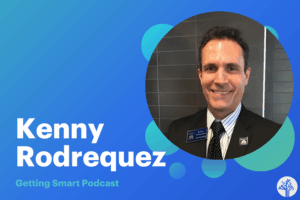Performance Contracting: Model for Governance, Provisioning & Accountability
I attend the National Association of Charter Sschool Authorizers Leadership Conference every year because I’m a disciple of Paul Hill. Almost 15 years ago, Paul got it about right in Reinventing Public Education: How Contracting Can Transform America’s Schools. Compared to the strange patchwork of local control, contracting offers a sensible way to govern America’s schools. A contact with a defined term that spells out roles, services, and performance expectations would beat the cloudy relationship that most schools have with their district and state.
Online learning has grown dramatically since Hill’s treatise, but the shift from education as a place to learning as a service with multiple providers makes the idea of performance contracting even more prescient.
Different than charters. Charter schools have been around for twenty years with well-established battle lines. Online learning is a more recent phenomenon but it probably engages more than twice as many students on a full and part time basis.
Online and blended learning was prominent on the NACSA conference agenda, but it is still a bit of a puzzle to the 900 U.S. authorizing entities. Here’s 10 ways that
- Online schools can enroll students on a full and part time basis (where states allow) creating a big new layer of choice
- Online services can serve very specific needs such as speech therapy, language acquisition, dropout recovery
- Online schools are not limited by the size of a building (but some states still limited the size of the school just to protect district enrollments)
- Online schools don’t need new locations (or new charters) to scale
- Online schools They don’t need to grow a grade level each year like most charter networks prefer; they can open K-12
- Online teachers can easily serve students in multiple locations even multiple states
- Online schools are inherently competency-based; they model individual progress and seat time requirements just seem silly
- Online schools and students benefit from more performance feedback
- Online and blended schools are more likely to utilize differentiated staffing models
- The national ranks of online providers is dominated by for-profit companies with massive scalability
Charters serve less than 5% of US kids, online learning maybe twice that (4x if we include part time use of computer based learning). What’s really different is that it is now possible to promise every U.S. student access to rigorous college prep courses taught by effective teachers. Existing online learning providers (for-profit, nonprofit, and school districts) could fulfill that promise second semester if state policy did not pose the barrier that it does today.
Growth in online enrollments is paralleled and propelled by the proliferation of cheap access devices and rapid adoption of viral apps and free resources by teachers, students, and parents—the bottoms up, outside-in pressure of learning technology is online learning isn’t just another reform fad, it’s a phase change.
Policy Issues. Blended learning may be inevitable, but there’s a lot of politics between here and there. Bryan Hassel, Public Impact, has been helping NACSA articulate their digital policy (although the Patrick-Vander Ark paper on Authorizing Online Learning and the Digital Learning Now Roadmap provide pretty good advice). Hassel’s thinks the performance contracting apparatus developed for charter schools is useful for cyber schools.
Hassel’s discussion draft suggests that states should avoid enrollment limits. Hassel recommends avoiding a new round of input controls including teacher certification and digital content reviews. He urges caution about radical budget cuts for online schools. Digital Learning Now recommends that funding be weighted, portable, and performance-based (and you can watch me describe future funding formulas in this zippy video).
To the questions, “Who owns outcomes” and “Who ensures quality,” Bryan suggests two versions of accountability. Either a school district carries the accountability and contracts with multiple providers or a student accesses multiple providers—each approved for statewide services—on a part time basis.
Given the growing likelihood of teachers working in teams in blended environments, Hassel suggests that if the state requires a teacher of record it should be the team lead.
Susan Patrick, iNACOL, said that what drew her to online learning a decade ago was the potential to expand access to quality and to personalize learning. She’s excited about the growth rate in online learning of almost 50% and a recent survey that indicated that about half of high school kids are interested in taking online courses.
Under her Susan’s leadership, iNACOL has become the leading advocate of competency-based learning, Just this year, iNACOL (where I’m a director) has published 4 reports on the topic.
Randy DeHoff from Colorado pointed out how gnarly it is to move away from systems based on 180 days given funding, testing, and employment practices and polices.
Political Issues. John Chubb, co-author of Liberating Learning, attributed the new landscape of U.S. higher ed to private sector investment in technology. He said it will eventually reshape K-12—state policy makers will influence the speed.
Rick Hess, author of The Same Thing Over and Over: How School Reformers Get Stuck in Yesterday’s Ideas, pointed to important outcomes—mastery of knowledge, critical thinking, and productive attitudes to name a few—and said that it’s clear technology will help deliver on some of those. He pointed to the knot of policy and practice the forms a resilient zeitgeist—an appropriate term given the system’s Bismarckian roots.
It’s clear that this isn’t the auto industry—automation won’t dramatically change employment patterns. But online learning will help some schools adjust to thinner staff patterns forced on them by the fiscal crisis. There will be a small shift from local to statewide employers. With the expansion of blended learning, there will also be a gradual shift to differentiated (i.e., different levels) and distributed (i.e., different locations) staffing.
Hess and Chubb clearly agree with John Bailey’s recent call for lifting the strange restrictions and limitations placed on private sector participation in education and not the National Education Policy Center’s call for even more regulation.
Performance contracting—not a very sexy topic, but useful ways to think about how as a society we provide for equal access to quality education for all students.







0 Comments
Leave a Comment
Your email address will not be published. All fields are required.